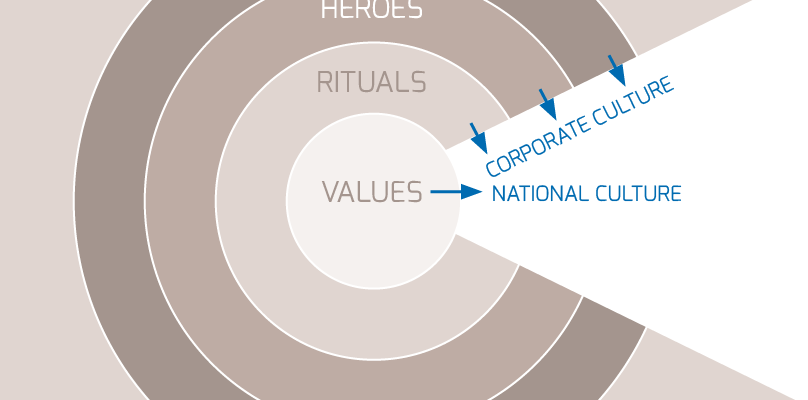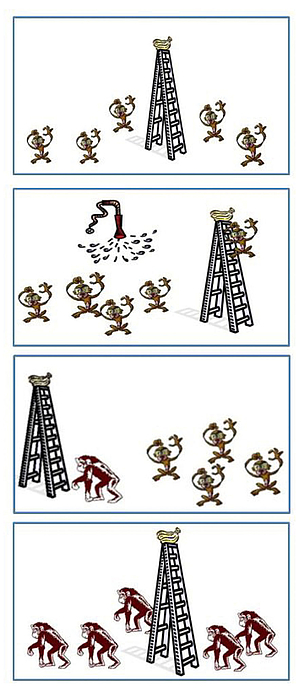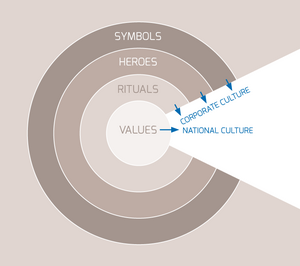

THE MONKEY EXPERIMENT /1/
A group of scientists put 5 monkeys in a cage and in the middle, a ladder with a banana on the top. Every time a monkey went up the ladder, the scientists soaked the rest of the monkeys with cold water.
After a while, every time a monkey went up the ladder, they beat up the one that climbed the ladder. After some time, no monkey dared go up the ladder, regardless of the temptation.
The scientists then decided to substitute one of the monkeys. The first thing this new monkey did was to go up the ladder. Immediately, the other monkeys beat him up. After several beatings, the new member learned not to climb the ladder, although he never knew why. A second monkey was substituted and the same thing occurred. The first monkey participated in the beating of the second monkey. A third monkey was substituted and the same thing happened. Then the fourth and finally the fifth one were substituted.
What was left was a group of 5 monkeys that although none of them ever received a cold shower, continued to beat up any monkey that attempted to climb the ladder.
If it were possible to ask the monkeys why they beat up all those who attempted to go up the ladder, I bet their answer would be: “I don’t know, that is the way things are done around here”
THE SCIENCE
I’d like to introduce you to a system which allows you to clearly and unequivocally measure ANY organisation’s culture and express it in a numeric score on a total of 8 dimensions (see Figure 2). Each dimension has a scale from 0 to 100 which allows you to take the subject of corporate culture out of the ‘fluffy’ domain and lift it into a rational and therefore much more easily manageable domain.
The Hofstede Multi-Focus model on Strategy, Culture and Change is THE ONLY model which is scientifically validated. It is a powerful tool designed to clearly measure your CORPORATE CULTURE. Further developed by Bob Waisfisz, founder of Itim International, and described in his book ‘Constructing the Best Culture to Perform /3/, it provides CHANGE TOOLS to align your CULTURE with your STRATEGY. These change tools are adjusted to the culture that is, and to the culture you need to create.
We define organisational culture as the way in which members of an organisation relate to EACH OTHER, their WORK and to the OUTSIDE WORLD. You could also say it is ‘The way we CHOOSE to do things around here’.
The various aspects of culture can be represented as different layers of an onion (see figure 1) and Organisational Culture is situated in the outer 3 layers. It’s about how we agree to do things in an organisation, our rituals, our heroes and our symbols.
National culture (described in detail in my previous article in Connecting Competence ONE:16) /4/, is at the core of the onion which represents the level of our deepest, mostly unconscious values.
We have learned those from our parents and our larger environment in the first 10 – 12 years of our life and they define what we believe to be normal. (Our ‘normal’). You can look at it as the way we were programmed in our younger years. It is part of our core programming, part of our operating system which is always there without us actually being aware of it.
Although often confused by many so-called specialists, Organisational Culture and National Culture are distinctly different.

OUR CHALLENGE
Multiple studies show that at least 65% of managers say that culture is more important than strategy or operating model. Yet very few can accurately describe their organisational culture. Studies also show that the majority of acquisitions and mergers do not achieve their targets, or even fail completely. Often this is attributed to differences in culture.
Participants in the 2015 annual convention of the IoD (UK Institute of Directors) will have noticed that managing corporate culture was highlighted as a major concern. The VW scandal was a hot media topic at the time, so it doesn’t come as a surprise that culture was highlighted as an important board-responsibility by several keynote speakers.
Peter Drucker once famously said that “Culture eats strategy for breakfast” and according to Lou Gerstner from IBM “Culture isn’t just one aspect of the game — it is the game”
In view of this, it appears strange that only very rarely, the aspect of organisational culture is actively incorporated in a business planning process.
So why is that? My view is that, although most leaders seem in agreement that it is really important, they struggle because they feel the subject is too ‘fluffy’, not properly measurable and therefore too difficult to really manage. Very often, the topic is side-lined and handed off to HR because they are used to dealing with ‘fluffy’ stuff rather than giving it the attention it deserves from top management, as well as from the Board of Directors.
CULTURE AND STRATEGY
Think of your own organisation and I am sure that enormous amounts of time and effort are spent on developing strategies and associated 3 to 5-year business plans, but little or none is spent on making sure that the organisation’s culture is aligned to ensure its strategy can be executed successfully.
Peter Drucker certainly didn’t mean to say that strategy wasn’t important. What he did mean is that you need to make sure that your organisational culture is an enabler and not a hindrance for your strategy. You can spend a fortune on developping a strategy but if ‘the way you do things’ within your organisation isn’t aligned with where you want the organisation to go, even the best strategy will be realized in a suboptimal way.
Simply put, strategy is mostly about ‘WHAT’ you want to achieve, whereas Organisational Culture is much more about ‘HOW’ you have to achieve your goals. I’m sure you can see that these two must go hand in hand to achieve optimal performance
A BALANCE SHEET
I like to compare managing an organisation’s culture to managing its financial accounts. Performing a measurement of an organisation’s culture gives you a clear and quantified snapshot of ‘how we do things around here’ at a particular point in time. It is very much comparable to a financial balance sheet at the end of each accounting period. We manage a balance sheet from one moment in time to another as a function of our strategy, by choosing how much to invest, how to finance it, where to get the revenues from, how to adjust the cost structure, etc. One could see this as a ‘change program’ for a balance sheet but we are so accustomed to doing this that we don’t think of it like that.
Managing your corporate culture is exactly the same. You take a snapshot at a point in time to have an ‘as is’ picture. Exactly the same way you manage your balance sheet as a function of your strategy, you manage your corporate culture by choosing to adapt practices, rituals and symbols to make sure you can execute your strategy properly. This can take many forms and can be as varied as changing roles and responsibilities, reporting lines, authority to make decisions, changing office layouts, communication systems, logo’s and symbols. The change tools connected to the model will help you to decide what to change and how to change it to best achieve your goals. Then, at the end of the next period, you take another snapshot to see if you’ve actually achieved your goals. You go on doing this for multiple periods (e.g. once a year or every 2 years) and BINGO, you now have a system with clear KPI’s (the scores on each of the dimensions), which you can track and integrate in whichever dashboard you use to run your business.

Fig. 2: The 8 dimensions of the Multi-Focus Model
EXAMPLES of application of the Multi-Focus model
# 1: Fostering Innovation
Most leaders want their organisations to become more innovative. In terms of the 8 dimensions, it is easy to see that if one wants to create an environment conducive to innovation, being goal-oriented rather than means-oriented (bureaucratic) will be helpful so the slider on D1 needs to be moved towards the right. At the same time, while some degree of control is obviously necessary, free thinking is essential to innovation. Therefore, you want to move the slider on D3 towards the left end of the scale to make the organisation more easy-going.
# 2: Increasing Diversity and Inclusion
Diversity and inclusion are some of today’s buzzwords. Many leaders want their organisations to become more diverse and more inclusive. It is not enough to just make a decision to become more diverse and more inclusive. The right atmosphere (corporate culture) needs to exist for diversity and inclusion to be accepted by those setting the tone in an organisation. The higher an organisation scores on D1 and D4 and the lower it scores on D3 and D5, the more it will help people to enjoy a high degree of diversity and the more inclusive the environment will be.
#3: Demonstrating a cultural turnaround
Since the 2008 - 2009 crash, quite a few investment banks are under pressure from the regulator to ‘improve’ their corporate culture. They all invest in training and some even have internal cultural ambassadors. However, the key question from the regulator always remains “Prove to me that your culture has changed” and many struggle to answer this question clearly.
The same is obviously true for any organisation that has a need to clearly and transparently demonstrate to its stakeholders that it is managing a cultural turnaround in a professional way.
Using the Multi-Focus model and by taking ‘before’ and ‘after’ snapshots, answering the regulator’s question is easy as 1 - 2 – 3.
#4: M & A
Company A is in the process of buying company B. They are in the same field of business and both are successful. However, for various reasons such as historic ownership structure, customer mix, geography, etc., the way they are organised and the way they have always conducted their business is very different.
A common misconception is that cultural differences are ‘de facto’ not a good thing. Within an organisation (especially larger ones), one always finds clear cultural differences between subgroups. For instance, top management needs to have a long term, holistic and strategic view, whereas the production department needs to be focused on the immediate job at hand and execute the work meticulously whilst respecting operational procedures. Such differences are necessary and are functional. If the reverse were the case, i.e. short term, procedural and meticulous top management versus long, term strategic thinking on the shop floor, that would be very dysfunctional.
The point I am making is that blaming cultural differences as such, as the reason for many M&A failures, is too simplistic. Just like one does a proper financial due diligence, conducting a cultural due diligence by measuring the organisational cultures of the various subgroups of BOTH companies, will clearly visualise the similarities and the differences. Building on this information, it becomes much easier to develop a transparent and manageable roadmap to ensure that the cultural aspects are properly managed and will be enablers rather than hindrances for the execution of the strategy.
CORPORATE CULTURE and ENGAGEMENT
Measuring employee engagement is standard practice in today’s world. It is usually accompanied by programs that try to increase employee engagement. However, people cannot be enticed or ordered to be engaged. Engagement is the result of a corporate culture that is aligned with its strategy. Employees know very well when the ‘WHAT’ and the ‘HOW’ are in sync or not in sync and it is precisely that which is at the core of engagement versus disengagement.
CONCLUSION
Managing the culture of an organisation no longer is a fluffy topic but can easily be incorporated into the management system. This provides immense value for any organisation as it makes it much easier to realize the strategy.
The comPETence center provides your organisation with a dynamic, cost effective way to promote your products and services.

magazine
Find our premium articles, interviews, reports and more
in 3 issues in 2025.





